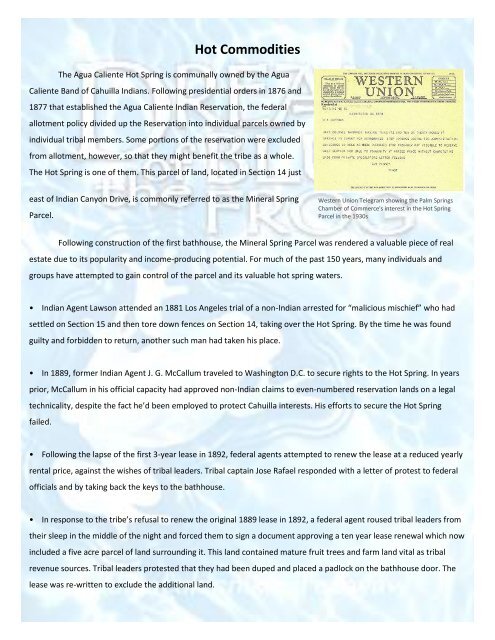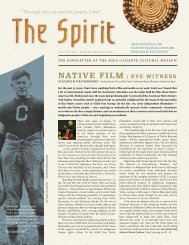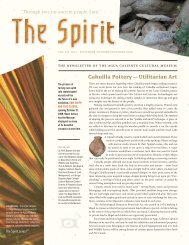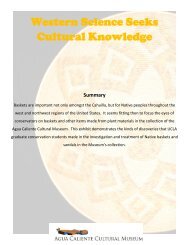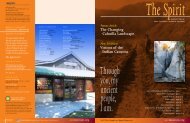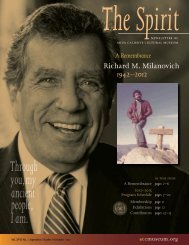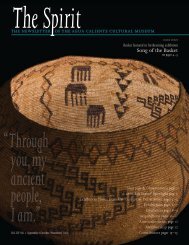You also want an ePaper? Increase the reach of your titles
YUMPU automatically turns print PDFs into web optimized ePapers that Google loves.
<strong>Hot</strong> Commodities<br />
The <strong>Agua</strong> <strong>Caliente</strong> <strong>Hot</strong> <strong>Spring</strong> is communally owned by the <strong>Agua</strong><br />
<strong>Caliente</strong> Band of Cahuilla Indians. Following presidential orders in 1876 and<br />
1877 that established the <strong>Agua</strong> <strong>Caliente</strong> Indian Reservation, the federal<br />
allotment policy divided up the Reservation into individual parcels owned by<br />
individual tribal members. Some portions of the reservation were excluded<br />
from allotment, however, so that they might benefit the tribe as a whole.<br />
The <strong>Hot</strong> <strong>Spring</strong> is one of them. This parcel of land, located in Section 14 just<br />
east of Indian Canyon Drive, is commonly referred to as the Mineral <strong>Spring</strong><br />
Parcel.<br />
Western Union Telegram showing the Palm <strong>Spring</strong>s<br />
Chamber of Commerce's interest in the <strong>Hot</strong> <strong>Spring</strong><br />
Parcel in the 1930s<br />
Following construction of the first bathhouse, the Mineral <strong>Spring</strong> Parcel was rendered a valuable piece of real<br />
estate due to its popularity and income-producing potential. For much of the past 150 years, many individuals and<br />
groups have attempted to gain control of the parcel and its valuable hot spring waters.<br />
• Indian Agent Lawson attended an 1881 Los Angeles trial of a non-Indian arrested for “malicious mischief” who had<br />
settled on Section 15 and then tore down fences on Section 14, taking over the <strong>Hot</strong> <strong>Spring</strong>. By the time he was found<br />
guilty and forbidden to return, another such man had taken his place.<br />
• In 1889, former Indian Agent J. G. McCallum traveled to Washington D.C. to secure rights to the <strong>Hot</strong> <strong>Spring</strong>. In years<br />
prior, McCallum in his official capacity had approved non-Indian claims to even-numbered reservation lands on a legal<br />
technicality, despite the fact he’d been employed to protect Cahuilla interests. His efforts to secure the <strong>Hot</strong> <strong>Spring</strong><br />
failed.<br />
• Following the lapse of the first 3-year lease in 1892, federal agents attempted to renew the lease at a reduced yearly<br />
rental price, against the wishes of tribal leaders. Tribal captain Jose Rafael responded with a letter of protest to federal<br />
officials and by taking back the keys to the bathhouse.<br />
• In response to the tribe’s refusal to renew the original 1889 lease in 1892, a federal agent roused tribal leaders from<br />
their sleep in the middle of the night and forced them to sign a document approving a ten year lease renewal which now<br />
included a five acre parcel of land surrounding it. This land contained mature fruit trees and farm land vital as tribal<br />
revenue sources. Tribal leaders protested that they had been duped and placed a padlock on the bathhouse door. The<br />
lease was re-written to exclude the additional land.


